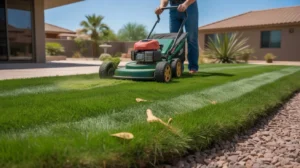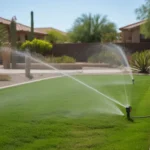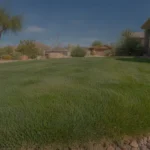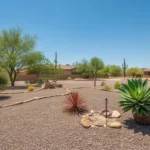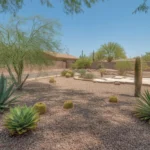As the scorching July sun beats down on Gilbert lawns, maintaining healthy Bermuda grass requires adjusting your mowing practices. Finding the best mowing height for Bermuda grass in July is crucial to promote deep roots, minimize stress, and keep your turf looking its best. Let’s explore the ideal mowing height and techniques to help your Bermuda grass thrive during the peak of summer.
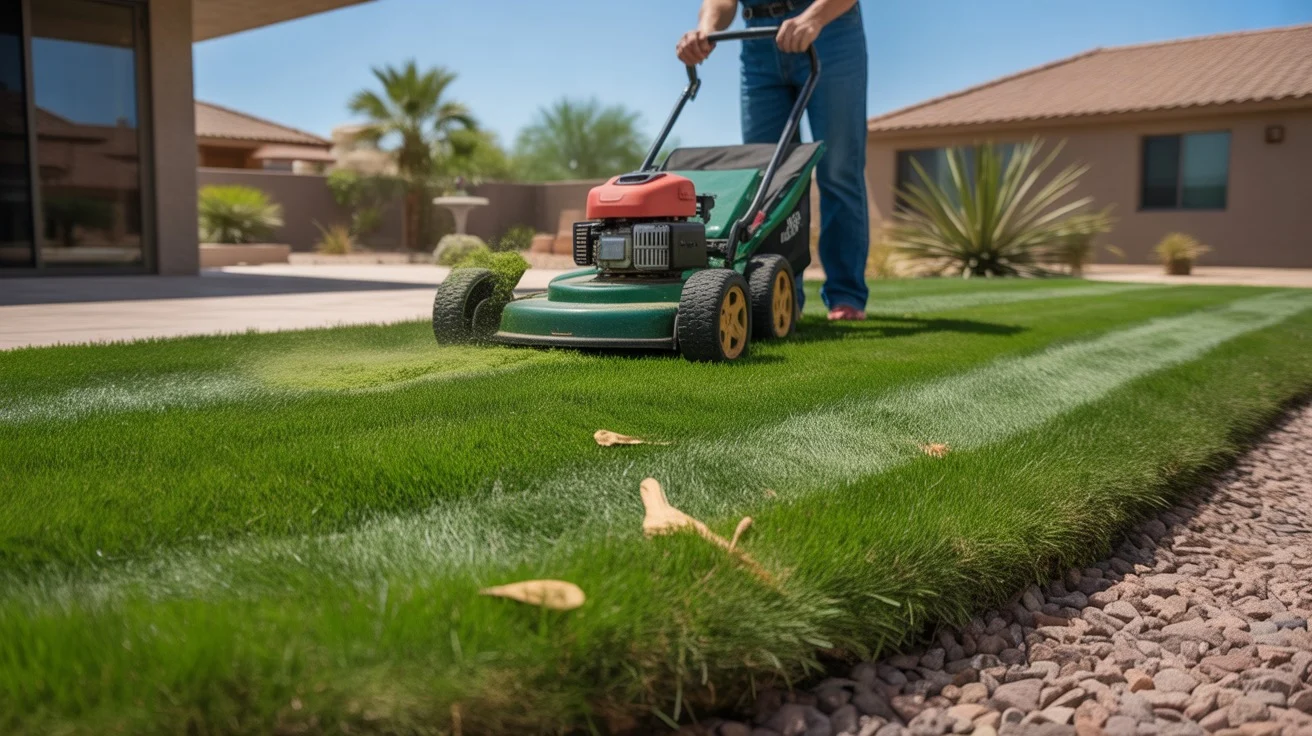
Understanding Bermuda Grass Growth in July
Bermuda grass is a warm-season turfgrass that thrives in the heat of Gilbert summers. As temperatures soar in July, this resilient grass continues to grow vigorously, requiring regular mowing to maintain its lush appearance. However, it’s essential to mow at the proper height to avoid damaging the grass and hindering its growth.
During July, Bermuda grass experiences rapid growth due to the intense sunlight and warm temperatures. This increased growth rate means that you may need to mow more frequently to keep your lawn looking tidy and well-maintained. Typically, Bermuda grass in Gilbert will require mowing every 5-7 days during the peak of summer.
When determining the best mowing height for Bermuda grass in July, consider factors such as the specific cultivar, soil conditions, and the amount of foot traffic your lawn receives. Adjusting your mowing height accordingly will help your Bermuda grass withstand the stresses of summer and maintain its health and appearance.
The Ideal Mowing Height for July
In Gilbert, the recommended mowing height for Bermuda grass in July is between 1 to 1.5 inches. This slightly higher mowing height compared to spring allows the grass to develop a deeper root system, which is essential for withstanding the intense heat and drought conditions common in July.
Mowing your Bermuda grass too short during the summer can be detrimental to its health. Scalping the grass, or cutting it below the recommended height, exposes the stems and soil to direct sunlight, leading to increased water evaporation and stress on the grass. This can result in a weakened root system, making the grass more susceptible to disease, pests, and heat damage.
On the other hand, allowing your Bermuda grass to grow too tall can also cause problems. When the grass blades become overgrown, they shade the lower portions of the plant, reducing photosynthesis and weakening the overall health of the turf. Additionally, tall grass is more prone to developing thatch, a layer of dead and living grass stems that can impede water and nutrient penetration.
Mowing Techniques for Optimal Results
In addition to maintaining the proper mowing height, employing the right mowing techniques is crucial for the health of your Bermuda grass in July. Always use sharp mower blades to ensure a clean cut and minimize damage to the grass blades. Dull blades tear the grass, leaving it more vulnerable to disease and stress.
When mowing, follow the one-third rule: never remove more than one-third of the grass blade height in a single mowing session. If your grass has grown too tall, gradually lower the mowing height over several mowing sessions to avoid shocking the grass. This gradual approach allows the grass to adapt and maintain its health.
Alternate your mowing pattern each time you mow to prevent soil compaction and encourage upright growth. Mowing in the same direction repeatedly can cause the grass to lean and create ruts in the soil. By changing the mowing pattern, you promote even growth and a more attractive lawn appearance.
Watering and Fertilizing in July
Proper mowing height alone isn’t enough to keep your Bermuda grass thriving in July. Adequate watering and fertilization are also essential components of summer lawn care in Gilbert.
During the hot and dry conditions of July, Bermuda grass requires deep and infrequent watering to encourage deep root growth. Water your lawn early in the morning, allowing the grass to absorb the moisture before the heat of the day sets in. Aim to provide 1 to 1.5 inches of water per week, adjusting for rainfall and specific soil conditions.
Fertilizing your Bermuda grass in July helps maintain its vibrant green color and supports its growth. Use a balanced, slow-release fertilizer specifically formulated for warm-season grasses. Follow the application rates recommended on the product label, and water the lawn thoroughly after applying the fertilizer to help it reach the roots.
Dealing with Summer Stressors
Even with proper mowing, watering, and fertilizing, Bermuda grass in Gilbert may face various stressors during the intense July heat. Heat stress, drought, and foot traffic can all take a toll on your lawn’s health.
To minimize stress on your Bermuda grass, avoid excessive foot traffic on the lawn during the hottest parts of the day. Encourage family members and guests to use designated paths or walkways to reduce soil compaction and grass damage.
If your lawn shows signs of heat stress, such as wilting or discoloration, provide additional water to help it recover. However, be cautious not to overwater, as this can lead to shallow root development and increase the risk of fungal diseases.
Adapting to Specific Cultivars
Gilbert homeowners have access to various Bermuda grass cultivars, each with its own unique characteristics and mowing requirements. Some popular cultivars include Tifway 419, TifSport, and Celebration.
Tifway 419 is a classic cultivar known for its fine texture and dense growth. It performs well at mowing heights between 0.5 to 1.5 inches, making it adaptable to July conditions in Gilbert. TifSport, on the other hand, is a newer cultivar with improved drought tolerance and disease resistance. It can be mowed slightly higher, between 1 to 2 inches, during the summer months.
Celebration Bermuda grass is another cultivar well-suited to Gilbert’s July climate. It has excellent heat and drought tolerance, allowing it to thrive even under intense summer conditions. Celebration can be mowed at heights between 0.75 to 1.5 inches, providing flexibility in your mowing routine.
When determining the best mowing height for your specific Bermuda grass cultivar in July, consult the recommendations provided by the grass seed or sod supplier. They can offer guidance tailored to your specific turfgrass and local growing conditions.
By maintaining the ideal mowing height for Bermuda grass in July, along with proper watering, fertilizing, and stress management techniques, you can keep your Gilbert lawn looking its best throughout the challenging summer months. A well-maintained Bermuda grass lawn not only enhances your home’s curb appeal but also provides a lush, resilient surface for outdoor activities and enjoyment.

